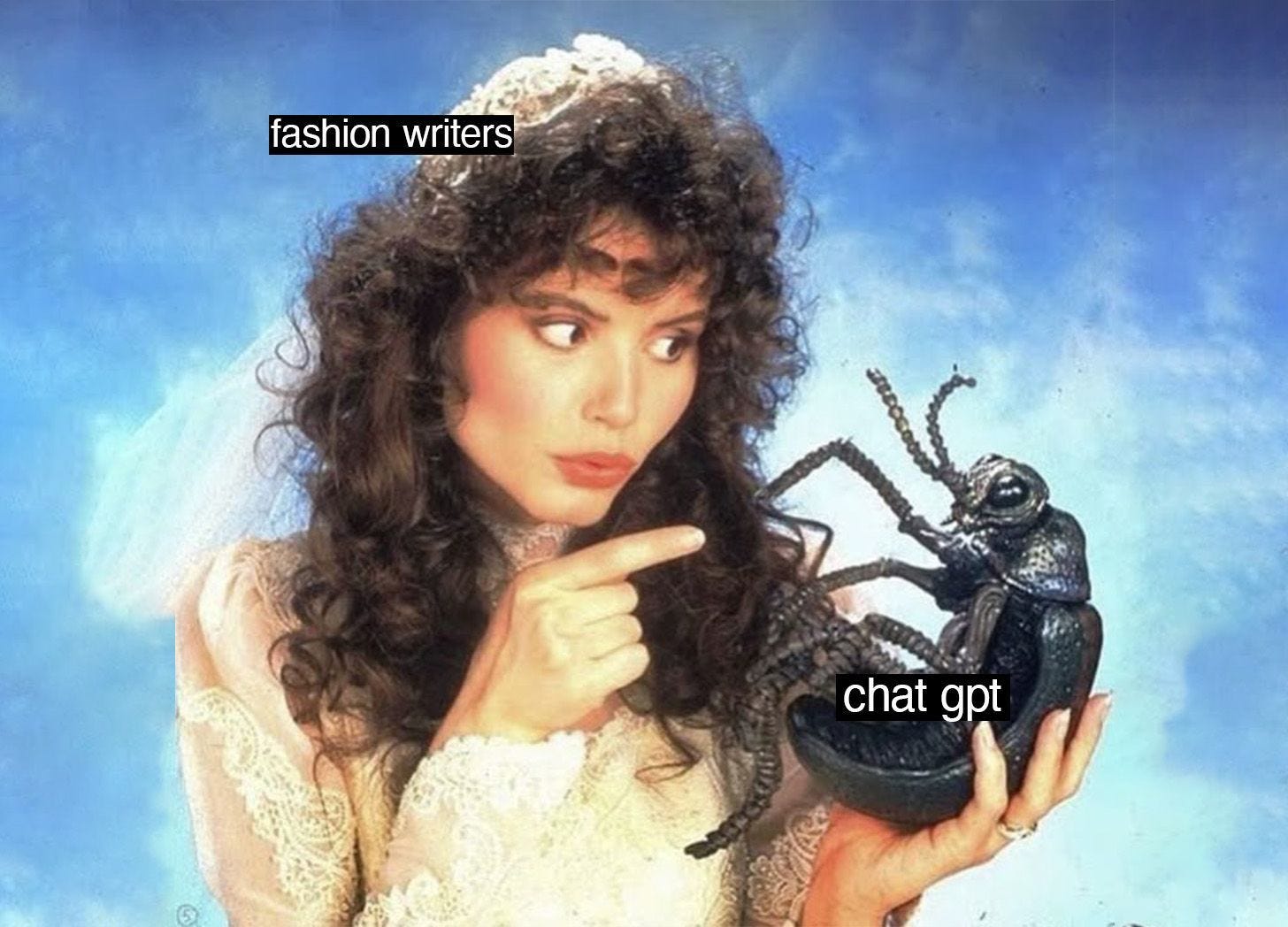Vibe check: How scared are fashion writers of ChatGPT
From newfound efficiency to existential crises about the future of journalism, a chorus of writers reflects on how AI is reshaping their creative terrain.
This story is part of our series AI’M SCARED, in which we explore the impact – good and bad – of AI on fashion and the creative industries. Read more of the series here: In an AI-driven world, taste is the ultimate currency.
By Jorinde Croese
As AI tools like ChatGPT become more embedded in the workflows of writers and editors, a critical question surfaces for those working at the intersection of fashion and journalism: will AI replace the fashion writer?
Over the past decade, slashed budgets, smaller editorial teams and bigger outputs has resulted in a steady decline in editorial standards for many publications in fashion. A push towards video, quicker, more digestible social media content and influencer-led strategies – i.e. forgoing expertise for number of followers instead – has completely shifted the goalposts for writers and editors. So, when efficiency and profit become valued above all else, AI represents a final nail in the coffin for some.
To understand this existential crisis better, we asked a range of editors, journalists, and cultural critics working in and around fashion to weigh in with their perspectives. Their responses reveal a shared resistance to the idea that machines could replace writers entirely – but also an awareness of the system-wide pressures pushing us closer to that reality.
The voice that AI can’t imitate
While some worry that generative tools are here to make writers obsolete, many emphasise a crucial point: voice, perspective, and lived experience are what set human writing apart.
"A machine can never do what I do," says Cassidy George, Features Editor at 032c. Even a bot trained to imitate my style cannot write as I do, because it lacks knowledge of the life I’ve lived. Our understanding of the world is shaped by lived experience – and writers are the sum of their references.”
Biz Sherbert, columnist for AnOther and writer of the American Style newsletter, echoes that sentiment: "What makes fashion writing worth reading to me is the perspective shaped by experience – memories from your childhood, outfits you see on the street, conversations you overhear at lunch."
Some went further still. "The whole point of fashion media is perspective," says Em Seely-Katz, writer of Esque!. "AI is a vacuum of perspective. It’s disturbing to entertain the idea that it could replace us, as if we couldn’t or shouldn’t resist that outcome."
For Scarlett Newman, the notion is almost offensive: "Writing about fashion is also an emotional output that is guided by our own interpretations... it would be an insult to my years of training and work as a journalist to rely on a ghost in the machine."
AI as a tool – not a replacement
Still, many of these same writers have found narrow, strategic uses for AI tools – most commonly in editing and transcription. Used sparingly, they offer a kind of time-saving support, especially for repetitive or tedious work. "Before I file any piece of writing, I put it into ChatGPT and tell it to check for spelling and grammar mistakes," George says. “It gives me peace of mind and saves me time, which can then be allocated toward things like deeper research or the more creative aspects of the job.”
Calum Gordon, brand editor at Carhartt’s WIP, agrees, with caveats. He found ChatGPT surprisingly helpful for cleaning up interview transcripts – until it started inventing things. "It just started inserting details that weren’t discussed or were directly contradicted. Bizarre. So scarily inaccurate."
Several respondents mentioned using Otter.ai or Rev for transcription, but with similar reservations. "It started out pretty janky, but it’s gotten more and more accurate," Lara Johnson-Wheeler says. "Still, I make sure to review the transcripts carefully to ensure much more accurate quotes." For some, even those small efficiencies come with a cost. “At the end of the day – and call me a Luddite – I love writing, every stage of the process (bar transcribing)," Madeleine Rothery says. “So why would I palm it off to a software?”
What we’re losing
Beyond the technical considerations, the rise of AI tools reflects and accelerates a broader shift already underway in fashion media: less time, less budget, and more pressure to produce. "The infrastructure of fashion journalism was already demanding a tool like ChatGPT before it arrived," Mary Cleary says. "Editors are forced to produce an almost constant stream of content to keep their publication high on Google search... a lot of writers are forced to sacrifice thoughtful, innovative writing in favour of quick, easy prose."
This environment is also reshaping career pathways. "There’s a vast ocean of those who work one or two rungs below the top-tier writers," Charlie Robin Jones says. "These people are in danger. If your work is dependent on aggregating and repeating with small changes, AI can replace it."
That shift isn’t just existential; it’s economic. As Cleary notes, many writers rely on commercial copy – Instagram captions, press releases, product descriptions – to make ends meet. "Brands trying to save money by using AI instead could mean a lot of people in the industry lose income they rely on," she says. "And because of that, we could lose a lot of talented voices – and also a diverse range of voices."




